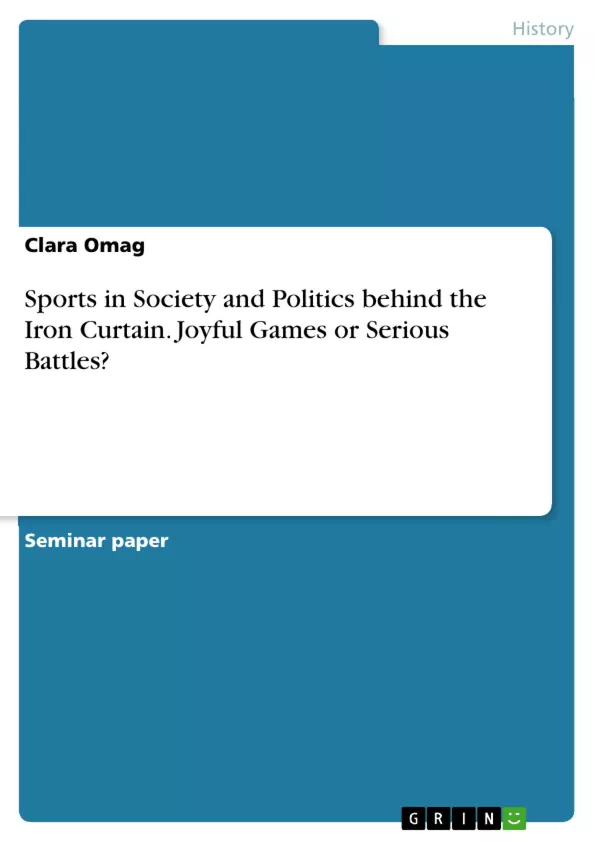In the Soviet Union, sport was an important part of everyday life, aiming to increase the health of the citizens and to make them fit for work. However, sport was controlled by the state and used as a major force to show the advantages of the communist ideology over capitalism. In the framework of the Cold War where the existence of two hostile world powers, the Soviet Union and the United States of America, were confronting each other, sports became an obvious field for international competition and for defeating the ideological opponent.
In this paper, it will be examined why sports gained more and more popularity in everyday life and how it was used as political force. The impact of policy will be shown on the specific example of ice hockey, one of the most popular sports on both sides of the Iron Curtain. In other words, it will be outlined how sport lost its innocence and became serious fun, a kind of weapon to wage war.
Table of Contents
- INTRODUCTION
- SPORT IN EVERYDAY LIFE
- REASONS FOR INCREASING SPORT ACTIVITY
- Increasing Prosperity
- Increasing free time
- Increasing Urbanization - Promotion of Sport in Town
- STATE'S INSTITUTIONS FOR PROMOTING SPORTS
- All-Union Committee on Physical Culture and Sport Affairs (Sports Committee)
- Voluntary sports society (VVS) and Sport Societies
- Sports Committee of Friendly Armies
- Schools
- SPORT AND MEDIA - HOW THE SOVIETS GOT INFORMATION ABOUT COMPETITIONS
- Television
- Newspapers
- THE CONNECTION BETWEEN SPORT AND POLITICS IN THE SOVIET UNION
- CREATING AN ELITE - SOVIET TOP ATHLETES AND THEIR MISSION
- COLD WAR ON COLD ICE: HOCKEY AS MIRROR OF POLITICAL EVENTS
- Political Revenge on Ice: Czechoslovakia's Triumph
- The American Miracle on Ice
Objectives and Key Themes
This paper aims to analyze the increasing popularity of sport in Soviet everyday life and its use as a political force during the postwar era. It examines the role of sport in strengthening the communist ideology and building a healthy and productive society. The paper explores the reasons behind the rise of sport in the USSR, including the influence of increasing prosperity, free time, and urbanization. It also investigates the specific example of ice hockey as a reflection of political events and tensions during the Cold War.
- The role of sport in Soviet society and its connection to political ideology
- The impact of increasing prosperity, free time, and urbanization on sport participation
- The state's active role in promoting and controlling sports
- The use of sport as a tool for international competition and ideological warfare during the Cold War
- The significance of ice hockey as a reflection of political events and tensions between the Soviet Union and the West
Chapter Summaries
- Introduction: This chapter provides an overview of the topic, highlighting the significance of sport in Soviet society and its use as a means to promote the communist ideology. It also explains the reasons for focusing on the postwar era and the importance of sport in the Cold War context.
- Sport in Everyday Life: This chapter explores the pervasiveness of sport in Soviet society, highlighting its role in promoting health, well-being, and national pride. It discusses the state's initiatives in promoting sports, including the establishment of sports institutions, programs, and facilities. The chapter also examines the role of media in disseminating information about sporting events.
- Reasons for Increasing Sport Activity: This chapter delves into the factors that contributed to the increasing popularity of sport in the late 1950s and early 1960s. It examines the impact of economic growth, increased free time, and urbanization on the Soviet population's participation in sport.
Keywords
The main keywords and focus topics of this paper include Soviet sport, Cold War, communist ideology, physical culture, state control, international competition, ice hockey, political propaganda, and societal transformation.
- Quote paper
- Clara Omag (Author), 2012, Sports in Society and Politics behind the Iron Curtain. Joyful Games or Serious Battles?, Munich, GRIN Verlag, https://www.hausarbeiten.de/document/337687


